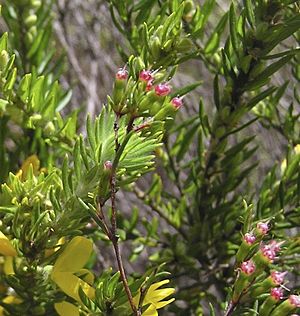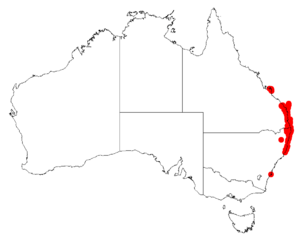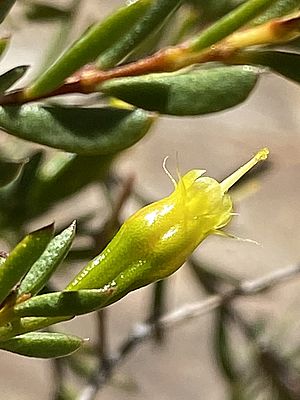Twiggy homoranthus facts for kids
Quick facts for kids Twiggy homoranthus |
|
|---|---|
 |
|
| Homoranthus virgatus in Broadwater National Park | |
| Scientific classification | |
| Genus: |
Homoranthus
|
| Species: |
virgatus
|
 |
|
| Occurrence data from AVH | |
Homoranthus virgatus is a unique flowering plant. It belongs to the Myrtaceae family, which also includes plants like eucalyptus. This special shrub only grows in coastal areas of northern New South Wales, Australia. It stands tall with branches that look like slender wands.
What Does it Look Like?
Homoranthus virgatus is easy to spot because of how it grows. It stands upright and has small, creamy-white flowers. The flowers have pointed parts called sepals. This plant also has leaves that smell nice! You can see its flowers from August to September. Its fruits appear from September to December.
Its Name and History
The scientific name Homoranthus virgatus was first officially written down in 1843. A botanist named Johannes Conrad Schauer described it. He used notes from another botanist, Allan Cunningham. The second part of its name, virgatus, is a Latin word. It means "of twigs" or "rod-like," which describes its twiggy branches.
Where Does it Grow?
This plant grows along the coast from Byfield in Queensland down to Laurieton in New South Wales. You can find it within 20 kilometers of the ocean. It also lives on some islands close to Australia's eastern coast. These islands include Fraser, Bribie, Morton, and Stradbroke Islands.
How is it Doing?
Homoranthus virgatus is doing well! It is found in many places and is often common in its local areas. Many of these plants are also protected in nature reserves. This means it is not currently in danger.


